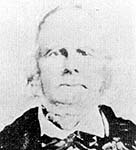Related Research Articles

Henry Hart Milman was an English historian and ecclesiastic.

Simon Dach was a German lyrical poet and hymnwriter, born in Memel, Duchy of Prussia.
Phineas Fletcher was an English poet, elder son of Dr Giles Fletcher, and brother of Giles the Younger. He was born at Cranbrook, Kent, and was baptized on 8 April 1582.

Charles Crozat Converse was an American attorney who also worked as a composer of church songs. He is notable for setting to music the words of Joseph Scriven to become the hymn "What a Friend We Have in Jesus". Converse published an arrangement of "The Death of Minnehaha", with words by Henry Wadsworth Longfellow.

William James Kirkpatrick was an American hymnwriter of Irish birth. He partnered with John R. Sweney to produce and publish over 1,000 gospel hymn songs and over sixty hymnal books.

Zera Pulsipher was a First Seven Presidents of the Seventy of the Church of Jesus Christ of Latter-day Saints. In that capacity, he provided leadership to the early Mormon community, most notably in the exodus of a large group of Saints from Kirtland, Ohio. He was also an active missionary who baptized Wilford Woodruff into the LDS Church.

Samuel Longfellow (1819–1892) was an American clergyman and hymn writer.
Ebenezer also known as Ton-y-Botel is a famous Welsh hymn tune composed by Thomas John Williams A.T.S.C. (1869–1944) and extracted from the second movement of his anthem "Goleu Yn Y Glyn".
The gospel song, Palms of Victory, also called "Deliverance Will Come", and "The Way-worn Traveler", was evidently written in 1836 by the Rev. John B. Matthias, a Methodist Episcopal minister in New York state. This attribution is not well documented, and Matthias had no known history of song-writing, but there is no other author to whom it can be attributed.
Haldor Lillenas was "one of the most important twentieth-century gospel hymn writers and publishers" and is regarded as "the most influential Wesleyan / Holiness songwriter and publisher in the 20th century". Additionally, Lillenas was an ordained minister in the Church of the Nazarene, author, song evangelist, poet, music publisher and prolific hymnwriter, who is estimated to have composed over 4,000 hymns, the most famous being Wonderful Grace of Jesus. In 1931 Lillenas was the producer of Glorious Gospel Songs, the first hymnal for the Church of the Nazarene. In 1982 Lillenas was inducted into the Gospel Music Hall of Fame.
Marion Elbridge Herrington, best known as Captain Mikey, was an American disc jockey; voice-over actor, who was the national voice for Sears; and innovative radio program director, who "pioneered album-oriented rock formats at San Jose's KOME and Los Angeles' KMET", and was described as "one of the very best programmers in Top 40 radio as well as what we called progressive rock on FM."
Oscar C. Eliason was a Swedish American clergyman, who served as a pastor and evangelist in the Assemblies of God, and was a prolific poet and composer, who composed over 50 hymns and gospel songs, including A Name I Highly Treasure and the popular Got Any Rivers?, which influenced another song, God Specializes, commonly regarded as one of the foundational songs of the traditional gospel genre.
"Cranbrook", also known as "Northampton", is a hymn tune composed in the 1790s or early 1800s by Thomas Clark (1775–1859), a cobbler from Canterbury, and is best known as the tune to the Yorkshire "national anthem" "On Ilkla Moor Baht 'at".

Elisha Albright Hoffman was a Presbyterian minister, composer of over 2,000 hymns and editor of over 50 song books. The son of an Evangelical minister, Hoffman grew up singing sacred hymns both in church and in the home with his parents. After completing high school, Hoffman furthered his education at Union Seminary in New Berlin, Pennsylvania, and was subsequently ordained as a Presbyterian minister in 1873.
Robert Hall Baynes was an Anglican priest, a hymnodist and a hymn writer. He was editor of the Lyra Anglicana, which was among the most influential hymnals of the Oxford Movement in the 1860s and 1870s, having a relatively broad selection of Anglican authors.

The Luther Monument is a group of statues that was erected in Worms, Rhineland-Palatinate, Germany, to commemorate the Protestant reformer Martin Luther. It was designed and partly made by Ernst Rietschel, and unveiled on 25 June 1868. The monument consists of a group of bronze statues on stone plinths centred on a statue of Luther, surrounded by statues of related individuals and allegorical statues representing related towns. The elements are arranged in the shape of a castle, recalling Luther's hymn "Ein feste Burg ist unser Gott". It is one of the largest Luther Monuments, and shaped views of the reformer. Copies of the central Luther statue are located in Europe and the United States, including the Luther Monument in Washington, D.C. (1884).

Nothing But The Blood of Jesus is a traditional American hymn about the blood atonement and propitiation for sin by the death of Jesus as explained in Hebrews 9. The song was composed by Robert Lowry, a hymn writer who was a Baptist minister and professor at Bucknell University.
J. Howard Entwisle (1865–1901) was an American songwriter and music compiler who wrote the music to the well-known Gospel song "Keep on the Sunny Side" (1899) with lyrics by Ada Blenkhorn. He also wrote "Beautiful Home" and the "Hallelujah Side," which have been recorded by several notable artists.